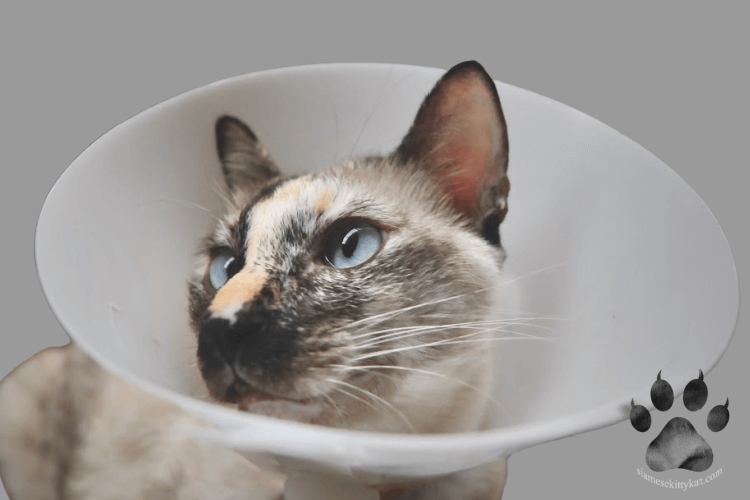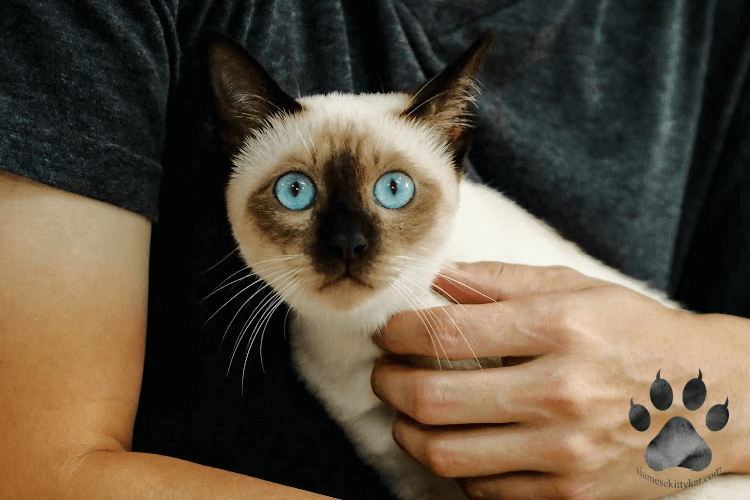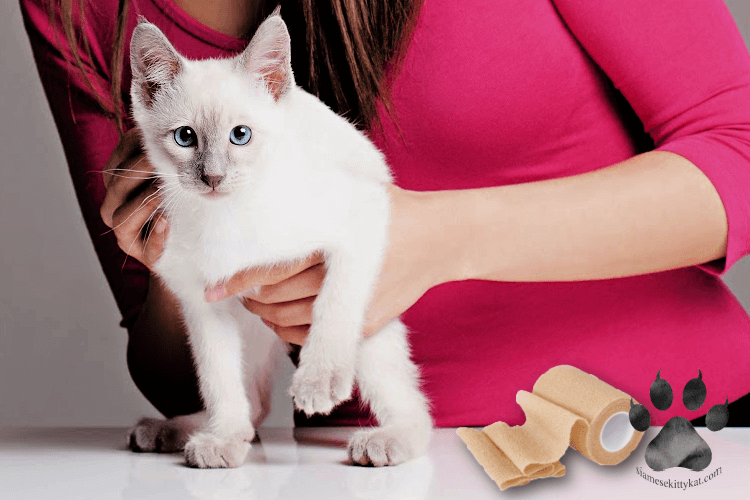Siamese cats have very thin skin, which can easily be punctured or cut. Most minor wounds will heal on their own, but it is still best to watch for signs of infection.
There are several simple steps that you can take to treat a Siamese cat’s wound and prevent it from becoming infected. Some of these steps may include cleaning the wound with antiseptic wipes, soap and water or applying an antibiotic ointment or spray.
I’ll cover the basics of wound care for Siamese cats in this article, so keep reading!
How Do You Tell if Your Siamese Cat is Wounded?
The signs of cat wounds can vary depending on the type and severity of the wound, as well as the individual cat’s response to that injury. Some common symptoms to be on the lookout for include the following:
Besides these physical symptoms, you may also notice changes in your cat’s behavior, such as:
Can a Siamese Cat’s Wound Heal by Itself?
The wound may be able to heal on its own with little or no intervention if it does not appear to be severe, is not causing your cat excessive discomfort, and is not being licked persistently by your cat.
Some of the factors that can affect whether a Siamese cat’s wounds will heal on their own include:
You must take your cat to see a vet if his wounds do not seem to be healing on their own several days. Your veterinarian can assess your cat’s wound and provide any necessary treatment or medications to help them heal properly.
How to Keep a Cat From Licking Their Wound

You should use an Elizabethan collar that is the right size and allows your cat to continue with everyday activities, such as eating or drinking.
An Elizabethan collar is a wearable cone made of plastic or fabric that fits around your cat’s neck and prevents him from reaching his body with his tongue.
You will need to measure the circumference of your cat’s neck to determine the appropriate size of the e-collar. Look for a collar that is not too tight or loose on your cat’s neck.
Your cat may initially be resistant to wearing the collar. Still, over time, he should be more comfortable with it and less likely to lick the wound on his body.
My Siamese cat, Batman, got a wound on his leg. The vet told me I needed to put an Elizabethan collar on him to prevent him from licking it. I had no idea what that was, but she showed me how to make one out of a piece of plastic. You just cut a slit in one side and then cut out a smaller circle in the center. Then you cut and bend back tabs around the center circle.
Batman didn’t like it one bit, but it did the trick. He couldn’t reach his wound, so it healed quickly and without complications.
In addition to using an e-collar, there are other steps that you can take to keep your cat from licking his wound. This may include providing them with various toys and distractions, or securing bandages in place, so they cannot be easily removed by your cat’s paws or teeth.
What Supplies Do You Need to Treat a Cat’s Wound?
You need to have the right supplies readily available when caring for wounds in cats. Some of the most valuable items include:
You may also want to have some sterile saline solution on hand, which can be used to clean wounds and flush out debris.
In addition to these basic supplies, you may also want to include some heat therapy products in your kit if your cat has experienced injuries related to inflammation or muscle pain.
How Can I Treat My Siamese Cat’s Wound at Home?

How to Treat a Minor Wound
Minor wounds are common for cats, especially those who like to explore the great outdoors. Siamese cats, in particular, are known for their curiosity and athleticism, which can sometimes lead to minor scrapes and cuts.
Most minor wounds are usually not serious, but they can be painful and uncomfortable for your cat. There are a few things you can do to treat a small cut or scrape on your cat at home.
How to Treat a More Serious Wound
Some of the most serious wounds in Siamese cats often come from fights with other animals or accidents. They can be difficult to treat if they are not caught early.
Take your Siamese cat to the vet if he sustains a wound that is bleeding profusely or appears infected. Wounds of this severity could have severe consequences if left untreated, including infection and even death in some cases.
Your veterinarian may prescribe antibiotics or recommend surgery to repair any damaged tissue or tendons for deep wounds.
Besides seeking medical care, provide your cat with plenty of love and support during his recovery. This can help keep him calm and comfortable while recovering from his injury. This minimizes the stress on his body and helps him get better faster.
How to Treat Eye Injuries
The eye is a sensitive organ; even a small wound can cause pain and damage. A small scratch on the cornea can cause blurred vision, and more serious wounds can lead to permanent blindness. Siamese cats are not the only ones at risk for eye injuries; all cats are susceptible to such injuries.
Seek medical attention as soon as possible if your cat sustains an injury to the eye.
How to Treat Burns
Siamese cats suffer from severe burns due to their thinner skin. Burns can cause damage to deep tissues, and the sooner treatment is received, the better chances for a full recovery.
Apply a cool, damp cloth to the area to help soothe the pain and reduce swelling. Create a safe environment for your Siamese to prevent burns.
They should never be left unsupervised around the fire, hot surfaces, or electrical appliances. In addition, all household chemicals should be kept out of reach of your Siamese cat.
Can I Put a Bandage on my Wounded Cat?

You can help to slow or stop the bleeding by applying pressure to the wound with a bandage. This will give you time to get your cat to the veterinarian for treatment. Use a clean bandage that is the right size for the wound.
Check the bandage frequently and replace it if it becomes wet or loose.
How Can I Promote my Siamese Cat’s Healing?
Handling your Siamese cat
Siamese cats are very good at hiding their pain, so it’s often not until they’re in grave distress that we realize something is wrong. You can do some things to make handling your Siamese cat a little easier.
- Try to approach him calmly and quietly. Avoid making sudden movements or loud noises, as this will only scare him and make him more difficult to catch.
- Support your cat’s weight with both hands when you’re picking him up. Never pick him up by the scruff of his neck or legs, as this can cause him distress.
- Find a way to give your cat his medication that doesn’t involve forcing him to take it. For example, you might be able to mix it into his food.
I was worried Batman would try to hide away when he got injured and make it difficult to treat his wound. As it turns out, I didn’t need to worry. Batman was very cooperative during his treatment and even enjoyed the extra attention.
I think it helped that I talked to him in a calm, friendly voice and explained what I was doing as I went along. He also seemed to appreciate the tasty treats I gave him after each session.
Creating a Sick Room
You will need to create a sick room to help your sick or injured cat to recover. You should have a safe, comfortable space for your Siamese cat to heal. The sick room should be quiet and free from distractions, with plenty of soft bedding for your cat to rest on.
Place a litter tray in the room, so your cat can easily access it, and provide plenty of fresh water. Lining the room with towels or blankets to provide extra insulation is also a good idea.
Once everything is in place, bring your Siamese into the sick room and show him around. Let him sniff and explore, so he knows this is his new space. Then, give him a few minutes to adjust before starting any treatment.
Spend as much time as possible snuggling, playing, and simply being with your cat. Creating a warm and loving environment will help your Siamese feel better in no time.
The best way to treat a Siamese cat’s wound is by providing it with proper care and attention. You should provide your cat with plenty of rest and nutritious food, minimize stress and avoid any situations that may cause further injury.
It may be helpful to consult with a veterinarian or other healthcare professional for advice specific to your cat’s unique situation. Taking a proactive and holistic approach to wound care can help your Siamese cat recover from their wounds and return to good health.
We gathered all the health tips tailored toward maintaining your Siamese cat’s optimal well-being. Check it out here: Siamese Cat Health: A Complete Guide
